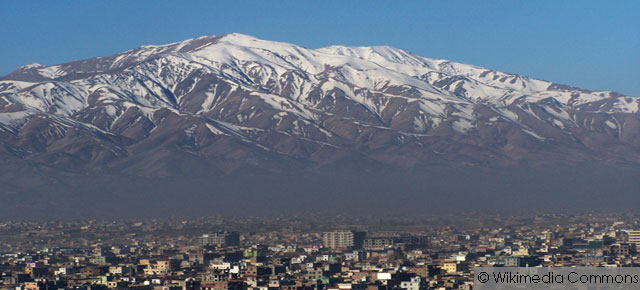 Alex Strick van Linschoten, co-editor of ‘My Life with the Taliban’ and ‘Poetry of the Taliban,’ and co-author of ‘An Enemy We Created: The Myth of the Taliban/Al Qaeda Merger in Afghanistan, 1970-2010’, argues that ISAF capture-or-kill raids are radicalising the Taliban insurgency.
Alex Strick van Linschoten, co-editor of ‘My Life with the Taliban’ and ‘Poetry of the Taliban,’ and co-author of ‘An Enemy We Created: The Myth of the Taliban/Al Qaeda Merger in Afghanistan, 1970-2010’, argues that ISAF capture-or-kill raids are radicalising the Taliban insurgency.
Attacks in Kabul on Tuesday are believed to have been carried out by those from or affiliated with the Pakistani group Lashkar-e Jhangvi al-Alami. Much of the commentary so far has looked at the extent of past precedent for sectarian tensions and violence in Afghanistan. A piece by Ghaith Abdul-Ahad asks whether the attack reflects a Sunni-Shi’i dynamic or rather ethnic issues, and Anand Gopal usefully notes that ‘a unilateral LeJ-Alami attack would mark a significant erosion of the Taliban’s control over the battlefield.’
The Afghan insurgency has long been – to a greater or lesser degree – a hodgepodge of different groups and actors. This is a situation the Taliban’s central leadership have previously been willing to tolerate; more affiliate fighters means more violence directed at foreign forces, even if these groups often turn their guns on other insurgent fighters or the general population at large. Periodically, the central leadership will attempt to clamp down on some of those who claim to fight under the Taliban banner. Several mass-casualty incidents in Kandahar last year, involving a significant proportion of dead and wounded civilians, saw an effort by the leadership to reinforce command-and-control structures. Similarly, the layeha, or rulebook issued by the Taliban leadership every year or two, has increasingly concerned itself with these issues of power retention.
The usual confusions of a messy conflict fought among the people mean it is difficult to penetrate all the inner machinations behind these events. However, one thing is clear: the Taliban’s central leadership (based, for the most part, in Karachi) have been steadily losing control over the violence in Afghanistan. This is not to say that they are a spent force, nor do I mean to imply that there aren’t insurgency command structures that function more or less as intended.
For a variety of reasons – best explored elsewhere for reasons of brevity – there has been a steady erosion of the ability of the old-generation leadership based in Pakistan to control the use of violence by the fighters that nominally pledge allegiance to the Taliban or ‘Islamic Emirate of Afghanistan.’ This is no great secret; the layeha itself implicitly acknowledges this diagnosis. In fact, the imagined breakup of the Afghan insurgency was one of the reason many outside parties and figures have sought an acceleration of ‘political solutions’ instead of continuing to rely on military options.
In case it needs repeating, the conflict in Afghanistan is a political conflict, one with a strong military dimension, to be sure, but also one whose seeming intractability reflects a yawning political entropy that grows with each day.
But do the current means of addressing this conflict really address the fundamental political issues or are they actually accelerating the very entropy they seek to avoid? I have argued elsewhere (together with my colleague, Felix Kuehn) that one of the things bearing significant responsibility for this fragmentation of the insurgency are capture-or-kill raids carried out by ISAF and Afghan security forces. Quite apart from the question of whether they are effective or not – a report written for the Afghanistan Analysts Network raised some of those issues – they have played a significant role in removing mid- and lower-tier Taliban leaders from the battlefield.
The capture-and-kill raids have been a quantifiable tool in the hands of ISAF to target the insurgency, but have they ended up radicalising the Taliban movement as an unwanted side-effect? There are numerous indications that this is the case. The insurgent commanders who replace those removed from the battlefield in ISAF operations are, for the most part, younger and often of a different ideological bent than their older predecessors.
Whether this is an explicit goal of the ISAF campaign, or just a side-effect, remains a significant question. Off-record briefings with American military officials and reports of conversations with special forces in the field frequently elicit admissions that it is an explicit goal of the capture-or-kill raids to ‘radicalise the insurgency.’ The idea seems to have come over from the experience of the US military in Iraq. Sidestepping the extent of US agency in radicalising actors in that conflict, a more radical Taliban would supposedly carry out more atrocities and, in so doing, would themselves drive a wedge between the insurgency and the people. In effect, the idea is a hangover from the golden days of counterinsurgency rhetoric.
International political and military actors didn’t come to Afghanistan with malign intentions, but the unintended consequences of their actions constantly threaten to overturn the very few unambiguously positive effects of their presence. Foreign money – in all its different forms – has arguably had more of a corrosive effect than the war itself.
Yesterday’s attack on an explicitly sectarian target may turn out to be yet another unintended consequence. The more radicalised the younger commanders become, the more they are willing to tolerate people from Pakistan coming in to ‘help out;’ just take a look at Kunar and Nuristan today. By the same token, the less control the Afghan Taliban’s central leadership has over things inside Afghanistan, the more chance we have of violence on the ground being hijacked by external groups with their own agendas: witness the Rabbani assassination.
A radicalised mid-level leadership that claims less and less allegiance to a senior leadership may be what the ISAF campaign intended to promote, but it can only harm the Afghan civilian population.